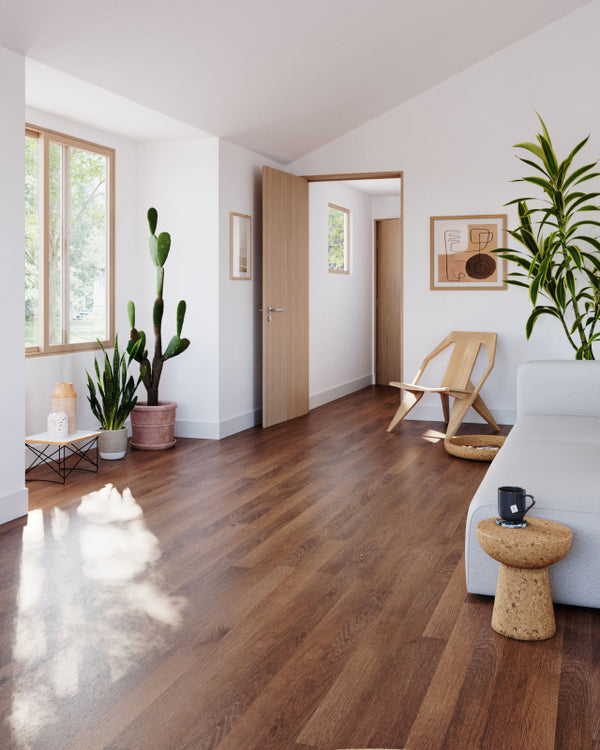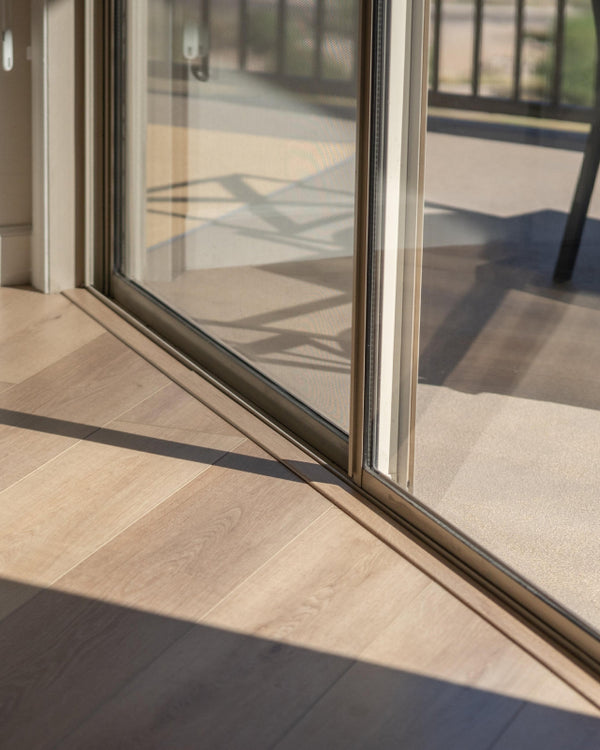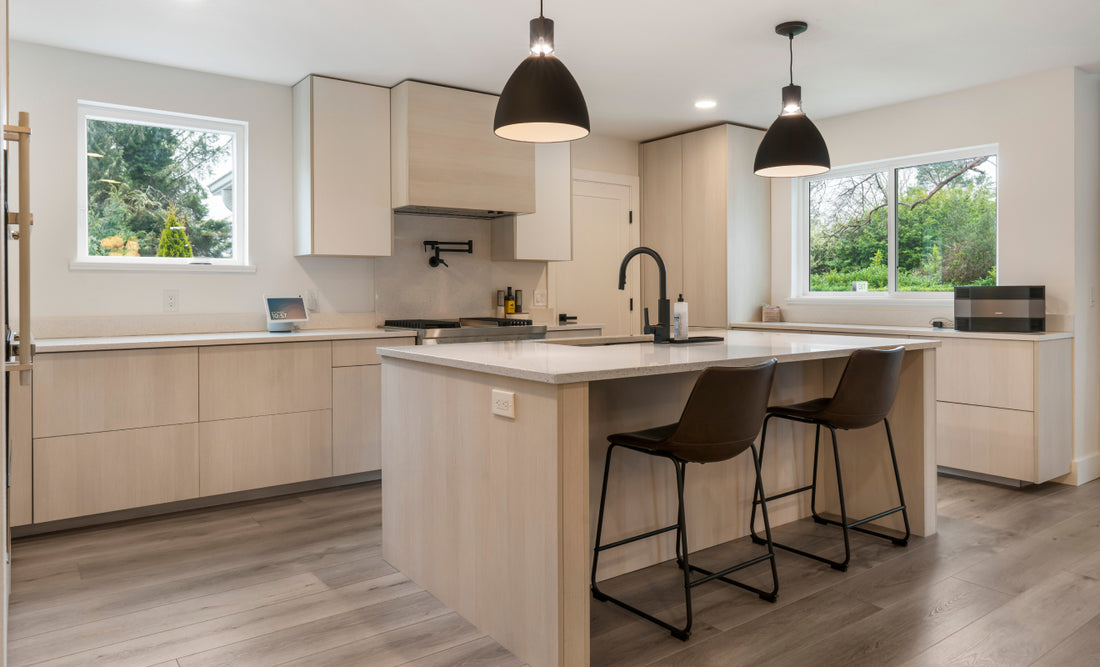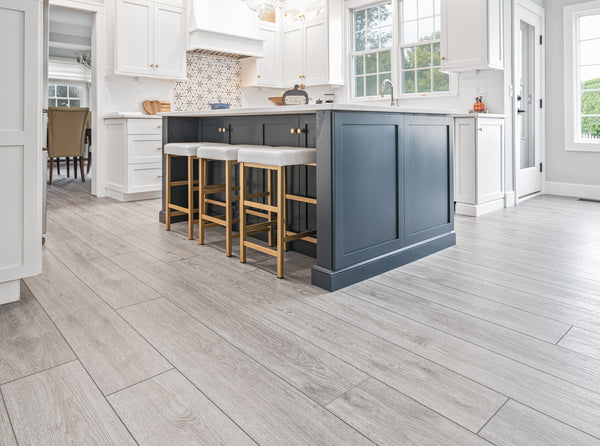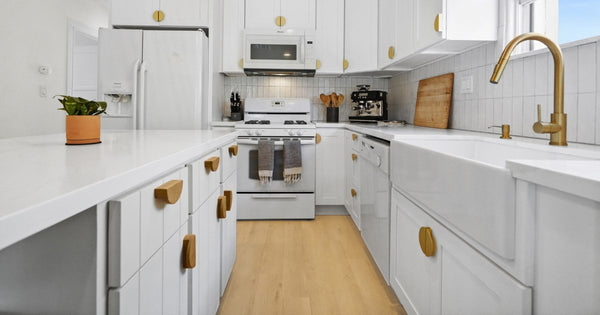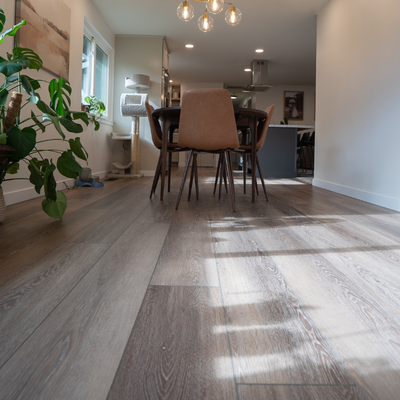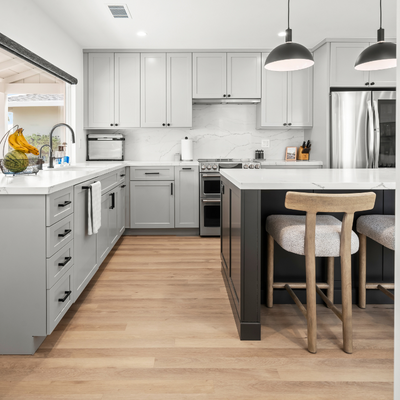Buying flooring can feel overwhelming, and it's hard to know where to start. Ultimately, choosing the right flooring means finding the one that makes you feel most comfortable in your space and that you will be happy to have in your home for years to come.
If you haven’t purchased flooring before, there are a few things you may not have thought to consider when making your choice. To help you feel confident in your decision, we’ve broken it down into 7 easy steps—from ordering samples to choosing your perfect floors.
Let’s dive in!
Step 1: Order samples
While browsing online is convenient, there's nothing quite like holding samples in your hand and seeing the colors and textures up close. You have a couple of options when it comes to ordering samples with Flooret. You can order individual cut samples, or you can opt for a sample kit to compare a variety of colors.
We have curated several sample kits to help you get started. Whether you’re interested in a specific collection, like Modin Luxury Vinyl Plank or Silvan Engineered Hardwood, or a particular colorway, like Medium Brown, there’s a sample kit for every style.
Step 2: Test the quality
Once you’ve received your samples, we recommend putting them to the test to make sure they meet your quality standards. Here are a few things to look out for:
Scratch Resistance: Test your sample by dropping your keys or other items that may frequently fall down in your space or lightly scratch at the surface with a coin.
If you get a scratch on your floors, there are a few ways you can fix it. Learn more here.

Safe for Spills: Spill some water on the surface of your sample to see the waterproofing in action.
Flooret’s Modin Luxury Vinyl Plank Collection is 100% waterproof, and Silvan Engineered Hardwood is topically waterproof, providing protection from inevitable spills.
See an expert test the technology.

Realistic looking: Apart from the floor's design, other features can affect its appearance. These details can determine whether the floor looks natural or artificial.
Embossing - Vinyl planks can have different textures ranging from flat (no embossing) to EIR (Embossed-in-Register). These textures make the flooring look more realistic by adding depth to the print film. EIR is the most realistic embossing pattern, where the embossing, or floor texture, perfectly matches the print film. The Modin Collection features EIR texture on every product.
Bevels - Bevels are grooves between planks that add detail and visually separate them. They prevent the planks from blending together, creating a distinct look. Bevels can vary in depth and style, with deeper ones resembling high-end wood flooring more closely. Common bevel types include square or straight edge (no bevel), micro bevels, pressed or natural bevels, and enhanced bevels.
Sheen - The urethane coating on the topmost layer of a floor can have different sheen levels. While mostly aesthetic, higher gloss levels can show more scratches, footprints, and wear, making low-sheen options more practical and visually appealing.

Durability: Wear layer is the key to long-lasting floors. In LVP, the wear layer is the durable layer of PVC on top of the realistic print film. It stands up to wear and tear, preserving and protecting your floors. In Engineered Hardwood flooring, contrary to what you might expect, a thinner wear layer can be a better choice since it allows the dense core of the flooring to support the hardwood layer, preventing dents at a much higher rate. What about refinishing?
Inspect the wear layer on your samples to see the difference.
DIY-Friendly: Test the click mechanism using two of your samples to see how easily they join together.
Step 3: Test in different lighting
Lighting is an essential but often overlooked aspect of interior design. It impacts the ambiance of your space and can even affect your floors' perceived color and tone.
Below are two images of Nakan Base from Flooret’s Modin Luxury Vinyl Plank Collection in the same home but in separate rooms with different lighting:


We recommend testing your samples in different lighting conditions to see the full range of colors and tones you might experience depending on where you install your floors.
Here’s how:
- View samples with the lights on and off.
- Compare them with the blinds open and closed.
- Observe them at different times of the day.
General rules for lighting
As a general design rule, consider coordinating your lighting source according to your space and its function. To do this, it helps to become familiar with the Kelvin Scale for lighting temperatures. As a quick rule, the higher the color temperature (measured in Kelvin (K)), the brighter and cooler the light. An easy way to break this down is:

As you consider the lighting in your home, here are some helpful tips:
Bedrooms & Living Room: Use warm lighting in rooms like bedrooms and living rooms, as those spaces benefit from a cozier and more comfortable atmosphere. Choose light sources with temperatures in the Kelvin scale around 2700K - 3000K.
Kitchen & Bathroom: For places like the kitchen, bathroom, or entryways, you might use a more neutral light around 3000k - 4500k. The cooler light temperatures, above 4500k, are typically used for commercial or workspaces, so they're not the best choice for your home.
Open Spaces: A general design rule is not to mix lighting sources of different temperatures in the same room. For example, if you have an open space with a kitchen, dining room, and living room, use only warm lighting with the same Kelvin value throughout the space.
If you want to explore other flooring colors and lighting options, try our innovative Roomvo 3D tool with customizable lighting to visualize each flooring option in various conditions and test new colors effortlessly. Select the flooring you’re interested in from this page. Once on the product page, click the “3D Plank” button.

While this feature is ideal for exploring different flooring options under varied lighting, nothing beats witnessing the effect in person due to the distinctive lighting nuances of your space.
Step 4: Matching your furniture and paint
Getting new flooring is an opportunity to redefine your space. Think about the style you're envisioning. Is it minimalistic, bold, rustic, traditional? Use your flooring samples to see which color will best help you achieve that style.
Simply lay your samples next to your walls, furniture, rugs, and kitchen cabinets to see how they look.
Experiment with mood boards
If you're starting from scratch or planning on changing more than just your floors, take a tip from the interior design pros and consider creating a mood board. This will help you see how different floors, paint colors, and fabrics interact to achieve your desired look.
Gather fabric swatches, paint samples, and other elements you're considering, then lay them out alongside your flooring samples. This is a great way to see how all of the elements in your space will ultimately work together.

Matching flooring & furniture: All about undertones
Flooring colors can be categorized into warm or cool undertones. For instance, grey flooring like Lachlan leans towards cool undertones, while medium-brown options like Kingswood have warm undertones. Neutral options, like Lato, don't have distinct cool or warm undertones.
A general rule of thumb is to pair the undertone of your flooring with the same undertone as your furniture.

Pairing flooring & paint: Complement, don’t compete
For a bold look, play with contrasts—dark floors with light walls, or vice versa. If you already have bold wall colors (and plan to keep them), opt for flooring with subtle patterns and colors so the two don't compete.
For a classic and timeless look, go with brown, warm-undertone flooring and neutral taupe, cream, or greige walls. Use the same undertone for a coordinated look.
If you're creating a minimalistic space, opt for light floors and walls. Add interest with subtly textured flooring (think wire brushing or knots) for a sleek yet captivating look.
A general rule is to find ways to contrast the two to varying degrees rather than to match your floor and paint or cabinet color exactly. Learn more about matching your flooring and cabinets.
Step 5: Consider additional samples
If you’re still deciding between colors, you may want to consider full plank samples. Our Modin LVP Collection offers full plank samples so you can get an even better sense of how your new flooring will feel in your space. If you haven’t decided which model to choose, this is a great way to compare the Signature, Base, and Craftsman plank sizes.
If you've narrowed down your options, try a full box order from the Modin LVP or Silvan Engineered Hardwood Collections. Once you have your full box, you can connect a few planks using their built-in click mechanisms to get a great picture of how they’ll look in your space.
Ordering full planks or a full box allows you to feel even more confident in your decision before placing a full order.
Step 6: Visualize your space
With just a few clicks, you can virtually "install" different flooring options using the Roomvo Room Studio tool. This tool can provide an added layer of certainty that you're selecting the perfect flooring for your space.
Here's how it works: Navigate to the Roomvo tool on our website and upload a picture of your room to get started. Explore various flooring colors and materials to get a realistic depiction of how each option will appear once fully installed. Try rotating the flooring within the tool to help you decide which direction to lay your floors.
A few things to consider when laying your flooring:
Choosing the direction to lay your planks can influence your space's visual appeal. It really comes down to personal preference, but there are a few things to consider when choosing which way to lay your floors.
Laying your flooring parallel, or vertically, can add a sense of depth to a short room. Parallel flooring often draws the eyes ahead toward an entryway, fireplace, or other architectural feature.

Laying your flooring perpendicular, or horizontally, draws the eye from side to side across a room. To make the room appear wider, or if installing in very small rooms or hallways, lay the planks perpendicular to the longest room dimension.

If you have angled walls, laying your planks diagonally might be the most visually interesting option. Another way to think about it is to install your flooring parallel to the largest light source.

Step 7: Placing a full order
How to measure your space
When ordering flooring, the first step is knowing how much square footage you need to cover.
Take a room that is 10’3’’ long and 20’8’’ wide:
- To multiply length and width, first convert both to feet. Convert 10'3" and 20'8" to feet by dividing the number of inches by 12:
- 3"/12"=.25
- 8"/12"=.667
- 10'3"=10.25'
- 20'8"=20.667'
- Multiply: 10.25' x 20.667'
- Your square footage is 211.84 square feet
When measuring rooms of irregular shapes, try organizing the space into rectangles and adding those measurements together.
Can't find your measuring tape? Try the "Measure My Room" tool when you click on a product image to get a rough calculation for square footage.

Placing your order
Once you have your square footage number, our site can calculate how many boxes you need to order. Enter your SF number, select whether or not you want to account for the recommended 8% overage, and checkout all in one place!
We recommend ordering 7-10% waste, depending on the size and layout of your project. Some room layouts result in more lost product due to cuts, and ordering extra will ensure a seamless, complete installation.
Flooring shipments are typically delivered via semi-trailers (18-wheelers). If your delivery address is located somewhere that could be difficult to access with a large truck, be sure to note that at checkout so we can ensure your shipment reaches you in a timely manner!
What to expect once you’ve placed your order
Once you've placed your full order, our team will prepare your flooring for transit. We highly recommend that you watch our shipping videos so you know what to expect as your floors make their way to you.
Questions?
When you work with us, you’ll connect with us directly—not a middleman. Our customer support team is the best in the biz, and no matter what you envision for your floors, our expert staff is here to guide you through all of our outstanding options.
Give us a call at 1-800-700-8122 or chat with us on our website!
